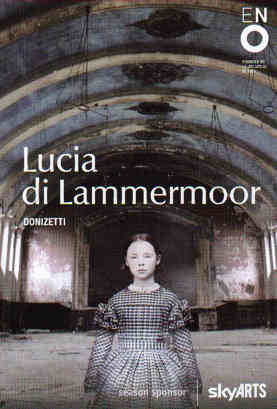Other Links
Editorial Board
- Editor - Bill Kenny
- London Editor-Melanie Eskenazi
- Founder - Len Mullenger
Google Site Search
SEEN
AND HEARD OPERA REVIEW
Donizetti,
Lucia di Lammermoor:
Soloists, Chorus and Orchestra of English National Opera/Paul
Daniel. 19.2. 2008 (CC)
In a sense, the cover of the programme booklet for
this Lucia says it all. Almost but not quite in black and
white, there is a hopelessness to the photo of the little girl
that is most disturbing. The concept is continued into the
production. Raising Donizetti to the level of quasi-Wagnerian
psycho-drama may seem ambitious, but one thing is for certain. It
results in fine theatre.

Stage colours are esssentially black, or dark, and white (but with
the light used to emphasise the dark). Only the red of blood adds
variety. Once the murder has taken place, Lucia appears with her
white dress soiled with fresh blood. When she turns to reveal the
extent of the spillage, it is a truly shocking moment.
The part of the titular heroine was taken by Anna
Christy, who is making her ENO debut. David Alden, the director,
sees Lucia as a child moving into adulthood (implied incest with
Enrico further added to the disturbing nature of events). Thus
toys are in evidence on stage; also, Lucia's attire is decidedly
girly. Her voice, too, initially seemed light – again, presumably
to fit in with the youth angle. No Callas here, but deliberately
so, for it was this Lucia's fragility that was to the fore. One
thing Christy has, though, is agility, something vital in this
repertoire, and particularly in the Act 3 Mad Scene. Christy
maintained the tension of this crucial, and extended, scene in
masterly fashion.
Mark Stone has impressed as a superb
Giovanni in the past, and his assumption of the role of Enrico
Ashton (Lucia's brother) brought another creditable performance.
His swagger and natural confidence suited the role well, and of
all the cast it was Stone who had the most stage presence. His
diction, too, was exemplary in a line-up that generally made the
surtitles a superfluity.
Clive Bayley was due to sing the part of the
chaplain, Raimondo, but illness meant that the part was taken by
Paul Whelan. Although Bayley has impressed in the past, it is good
to make mention of the (very tall!) Whelan's excellence. Barry
Banks took the part of the bridegroom, Edgardo. Banks, who is a
regular on the wonderul
Opera Rara label, was a kilt-wearing dandy, a groom whose
anger at the end of Act 2 was completely believable. This was a
long way from his hammy contribution to Christine Brewer's
otherwise excellent
Chandos showcase disc.
Michael Colvin was a rather bleaty Normanno. A
special mention is due, however, to mezzo Sarah Pring's Alisa.
Pring was strong in both voice and presence. I hope to hear and
see more of her as her ENO repertoire grows.
Paul Daniel is a conductor whose ENO appearances
have resulted in a decidedly mixed bag. His Wagner always seemed
weak, yet his Britten
Midsummer Night's Dream and
Rape of Lucretia were memorable. As the bel canto
repertoire has been under-represented at the Coliseum in recent
times, this Lucia was an unknown quantity. As it was,
Daniel 's conducting was focussed and even inspiring, with few of
the ragged orchestral ends that characterised his Wagner
performances. The storm at the opening of the final act was
visceral rather than marked by bombast, while Daniel brought
appropriately dark timbres to the Prelude to Act 2. The time away
from his old stomping ground has clearly brought freshness to the
relationship between conductor and his players.
There is a tremendously informed booklet note by
Roger Parker, a scholar based at King's College London who also,
along with Gabriele Dotto, edited the critical version of the
score that was presented here.
Colin Clarke
Back
to Top
Cumulative Index Page
